H.A. Byrd's Blog
October 3, 2024
Real Stories
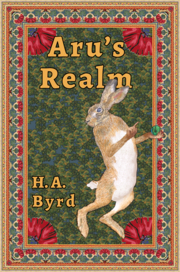
Although my Aru���s Realm is a fantasy, it intersects constantly with our real world. This is why the hare on the cover allows his ears to obscure the M in the title.
The reality we can discuss with the least danger of spoilers is that this book might be labeled an autobiography. I���m not Aru, and she���s not me, but the story is not as fictional as one might imagine. I drew heavily on my own experiences. What the character Aru and I have in common is that we each possess a proclivity for adventure-taking.

I took my very first gulp of air in a room at Peninsula Hospital in San Francisco. At the time, my family lived in a beautiful varnished-wood house on a hill, with a distant view of the bay. But when I was five, my father had a heart attack. His boss felt bad for placing him under so much stress in his Electrical Engineering job, and he transferred Daddy to their facility in Sacramento. We moved to a rural area not far from Folsom Prison. When I was ten we moved to Saskatoon, and later to Toronto and then BC.

I enjoyed my childhood. I spent it swimming in nearby lakes, ice skating outdoors, and riding bikes and horses for hours at a time. I climbed a few trees, but never nearly as high as my two older sisters. I read a lot. A lot. I wrote stories and drew hundreds and hundreds of horses and fantastic creatures.

When we moved back to the States I came from homeschool to a rather nasty school district. I retreated to the art rooms. Before long, I started riding the Metro bus across the lake to downtown Seattle, spending my junior high afterschool time in the University District. By my junior and senior years, I carried along a backpack three times a week to sell my batiks at Pike Place Market. I had friends from around the world there, and a wonderful inventive craftsman boyfriend who would get mad when people said he looked like Jesus.
I went off to college in search of adventure, and that���s how I���ve continued to approach life. I was looking for answers, too, but along the way, I learned that there really are no answers. I studied Eastern philosophy when I was a kid, and in my twenties found myself learning the spiritual teachings ancient to the land where I live. I���ve lived within the Native community and had a Medicine perspective for most of my life. My husband and sons carry that traditional understanding in their own ways. These views are central to my writing.
I���ve traveled a fair amount, always with little money and often with the assistance of some type of large animal. For every chapter of Aru���s Realm, I���ve been to a place like that and I've had a bizarre amount of those experiences. I have not, however, been kidnapped.

The real world is a fascinating place. People who travel or do adventurous things have amazing stories to tell. The other day a dear friend happened to mention something a Buddhist monk said to her in Zimbabwe. Zimbabwe���what? I knew she had a passion for Alaska, she'd kayaked there from Puget Sound. And she spends time in Australia. Africa, though! When did that happen?
My friends who prefer the beauty of their homes and local surroundings have remarkable stories too. Whether they express their experience through words or colors, or maybe in how they carry themselves, they all have stories about the joy or challenges life brings, and about their own special perspectives. In the end, perception comes back to the beginner���s mind. Simple, daily tasks root us in reality. We can discover the secrets of the universe in our own garden or kitchen. As I grow older, I see more clearly how important family and friends are in one���s life. Some of the memories I cherish most are those belonging to other people.
August 21, 2024
The Ball Net

While out walking dogs today I passed a ten-year-old boy playing alone in his driveway, throwing basketballs at a hoop. The feeling of a dystopian novel of the 1950s came over me. Here we were, on a suburban street that poked its way into the farmland forest. Pleasant ranch-style houses with expansive clipped lawns intruded on the firs and cedars. Calls of the Steller's jay and the thump of the ball were the only sounds on the wind. But that wasn���t just one ball.
A big net around the entire basket and free-standing backboard funneled the kid���s shots into a blue apparatus below, whether the ball made the hoop or not. Every couple of seconds the machine shot another basketball back at the boy. I���m not a sports person, but I imagine these ball shooters are common in high schools and colleges, and surely the NBA. They must be great for muscle memory and to give a team an edge.
I don���t know how many kids have a ball shooter of their own. I suppose this guy is lucky. But he wasn���t running back and forth to retrieve his basketball. He wasn���t laughing with friends, or reaching down to grab a ball. He stood, endlessly, tossing balls at the hoop. Thud. Thud. Thud. Thud. So he can be better at this game than his friends. Maybe become a star and make lots of money. Thud. Thud. Thud. He was, like, ten years old.
Although I know nothing about his life or what he does with his time otherwise, this glimpsed moment of a boy���s private play gave rise to several of my pet peeves. Before I launch into the tirade that I feel welling up inside me, I���ll pause a moment. I���ll hold my tongue.

I���ll take a step back and give space to the opinions of others who might react to an image like this. I suppose there could be all kinds of thoughts. Depending on a person���s background, they might be proud that our great country makes it possible for a neighborhood boy to enjoy this type of technology. They may smile to see a young boy working so hard at something. Perhaps they might feel jealous, or indignant, or uninterested. They���ll have some sort of response though, even if it���s none.
We bring our entire life history, and the baggage that comes with it, to everything we do. Our perspectives are formed by our experiences and the choices we have made. Life is seen by each of us through lenses tinted by opinion and all the influences that we allow to affect that opinion.
My story Aru���s Realm is meant to remind people that there are many realities in our world. Although we live together as drops of water in a great cosmic sea, sharing human depths of recognition, we also have our unique presence with its own view.
Life is a book we each read, but like all readers of books, we bring our personal memories and influences to the page. Once shared, a story no longer belongs to the writer. It becomes a different tale for each one who takes the journey through it. Life is like that, too.
 Anyway, this is how my thoughts run as I���m out walking the dogs.
Anyway, this is how my thoughts run as I���m out walking the dogs.
January 2, 2023
Transformation and Color

My sister Crista was horse crazy. When I was four years old, Crista was knee deep in horse models and riding lessons. She owned all the Marguerite Henry books, and others about horsemanship and horse care. By the time she had her first horse, four years later when she was twelve, she had exhausted the library's supply of horse books. One day she brought home The Horse And His Boy because of the title, which led to her to read the rest of the Chronicles of Narnia, and then The Hobbit, followed by The Lord of The Rings. I read these and the other fantasy books that Crista recommended to me over the years of my childhood. Crista was hooked on fantasy, and so was I.

One can only read so many fantasy novels before one thinks of writing one's own. At the age of seventeen, I sat down to release the great story that I knew was within me. I happily rolled up my sleeves to type, but nothing made it to the paper. Every idea I had, and there were many, involved Tolkien's elves, George MacDonald's goblins, or a plot from The Dark Is Rising Sequence. I could not come up with an original concept.

This bothered me very much, so I made a vow not to read any more fantasy until I had written my own. This goes against the standard advice for writers, the Number One Rule: If you wish to write, you must read, read, read. Of course, by this time in my life, I had read an enormous amount of fiction, mostly in the fantasy genre. And so I kept my promise, with a caveat. I allowed myself to read fantasy books to my children when I read aloud each night for many years, but only stories I'd read growing up. The exceptions were the early Harry Potter books, which my sons had already read, because they insisted I read them. Yes, aside from the Potter books I kept my vow, even though several decades passed before I began Aru's Realm.

I wrote a couple of chapters of Aru's Realm in the same year that Y2K was a big worry. Those short chapters of the early draft were quite different from the eventual story, of course, but did contain the same basic ideas. This is why I sat down and cried when the Prisoner of Azkaban came out. (Spoilers here if that one is on your TBR list.) I cried because one of the unique aspects of Aru's Realm was that the characters transform between human and animal. My story is written with hints beginning on the first page to spur the reader to slowly figure out that these people are animal people. (It doesn't spoil the story to know this.) Each passing character on Aru's journey is described in order to give a chance to guess the type of animal. When J K Rowling wrote about shapeshifters, she was the first popular author to focus on that ancient magical tradition beyond the werewolf or the vampire, at least that I can think of. Tolkein had Beorn, other stories had skin-changers, but it was not a "thing." After Azkaban, and later, unfortunately, Twilight, "shifter" became a sub-genre. Of paranormal romance, no less.

After those first few chapters made their way into the world, I had to pause my writing for a while. I had another project involving my children which required a great deal of writing, and our family moved to a different state. My story wasn't a priority. So Aru waited. Fifteen years later, as I drove an eighteen-wheeler among the magnificent red rock formations of Moab, Utah, those rocks spoke to me. Those colorful ancients told me, clearly, that it was time. I'd been gathering notes for my story for decades, since I was seventeen. But now it was Time.

I began by organizing words and ideas by color. I wanted each chapter to give the reader the impression of a different color. This is more difficult than it may at first sound, and is largely why the story took so long to write. The story flowed. I felt as if I were a sculptor, chipping away to reveal an art object which already existed. Never once did I have a moment of writer's block. Even so, although I took jobs which allowed me to write for much of the time, such as home health care, and spent most of each day writing, it was four solid years before the editing began.

If you think about it, not all nouns which bring a certain color to mind will cause people to think of that specific color. For instance, a dandelion is yellow, but only before it has gone to seed. It becomes a white globe. This is how it will come to mind for many people. The sun, however, is consistently pictured as yellow. If you'd like a bit of fun, try this: Think of five items which are more than likely to bring up an image of yellow. Foods are easy, so don't include those. If this isn't enough of a challenge, use the color green instead, and exclude plant life. Come up with some green animals! Maybe try some other colors! Words which contain the color name, or refer to a place in our world (cologne, Lipazzan stallions) are not allowed. For a word to have been included in this story, it would have had to exist in the nineteenth century and couldn't be associated with war. Probably almost anyone would have let the idea of this book about color fade away soon after the thought came to them. I'm not exactly sure what that says about me. I'm happy that I spent the time, though, because through the use of color association in the portrayal of events and emotions, and also through calculated, carefully honed description, each chapter fully surrounds the reader with the feeling of a particular color. This unique approach is one of the reasons I'm proud of my story Aru's Realm.

I have a pattern of creating hurdles for myself both in my journey through life and in my writing. The difference is, the hurdles I create as creative challenges are much more fun.
November 30, 2022
Patterns of Life

Gazing up at bare maple branches on a cool November day, I���m reminded of the tributaries of a river, with little streams merging into larger and larger ones on their way to the sea. The same pattern is hidden inside of each of us, as the branches of our circulatory system deliver the heartbeat blood flow which gives us life.
We don���t tend to think about our blood vessels much, not unless our heart is pounding or maybe the nurse is trying to find a vein. I started paying more attention a while ago, after surgery caused damage to the arteries of my leg. Over time, amazing healing powers of the human body brought relief. I���m happy to say that discomfort is no longer an issue. But life events can direct our journey. It���s because at one point I had trouble standing or sitting for any amount of time that I became a dog walker.

I love walking dogs. I named my business Frolicsome Dog Walks because what I do is take dogs out to play. This is the best business in the world. My furry clients wiggle and dance with joy when I arrive! We pick a direction and head out. The dogs will stop and sniff at a huckleberry bush or the corner of a fence, and I���ll pick up a fallen leaf and admire the red veins in the golden yellow. Each day is a new adventure. And what better activity than walking could complement the lovely but sedentary art of writing? The happenstance of life has pointed me in a fortunate direction.
Most people enjoy a nice walk, but it can be tough to find the time. One reason some folks get a dog is in order to force themselves to go outside regularly. Ha, as I write this, my Pippa is staring at me. Okay, Pippa.

I'll be right back.

Hello again.
After all this time, I have yet to dread a dog walk, but there are days I would have stayed snug indoors if I didn't have the professional commitment. Once out, I am happy to walk. My neighborhood sits at the confluence of the branches of a river and has some great places to explore. Even better, though, the weekends allow walking along the seashore or in the mountains with Pippa. The Northwest Coast has astounding beauty.
My ancestors walked the forests of Denmark and England, yet for me a hike through these Pacific Northwest woods is like stepping back through time. When I look around, I can almost remember, somehow, the old growth forest of a hundred years ago. Among the trees the river tumbled in the same way over boulders, and the woodpeckers went after the snags with just as much gusto. When I���m out in the wilderness I can imagine what it must have been like for those who came up these rivers and streams to hunt or forage in those times long past.

I love a nice hot shower, a massage, or a session of yoga, and these or a good stroll reduce levels of the body's stress hormones. Walking also produces endorphins that both make me feel better and help me concentrate and feel mentally sharp. Exercise gets the blood flowing, which feeds more oxygen to my muscles and brain. A walk out in the fresh air opens the way for inspiration.
They say what goes around, comes around. This is true within one���s own personal sphere, too. I���ve found that when I do something nice for my health, it comes back to reward me. On a day filled with all sorts of maintenance and housekeeping, I may struggle to squeeze in some time to write, but I���ve found a way to consistently include taking a break and getting some exercise. Dog walking is fun in its own right, but it has also helped me build up strength for hiking in the mountains.
I love to go outside. In nature we see differently, away from mental patterns which can sometimes hold us back.
When we look at a beautiful scene, what reaches our eyes are patterns of light. And that���s what we are, ultimately. Patterns of light.
October 10, 2022
Tiredness, Stubbornness, Happiness

When I get too tired I spend more of my time daydreaming. As I walk along, minding my own business, the simplest random thought or some sight along my way will trigger a long and involved scenario about something I might have done better at some point in my life. Or maybe it will be about some action, full of righteousness, which I will never actually take. Lost in thought, all due to fatigue. I guess the back of my mind figures I���m not watching and takes the reins, churning over something���anything���which has caused me stress, ever, in my life. I���ll find that I���ve gone for a quarter mile without particularly noticing my surroundings.
I don���t want to focus on these sorts of thoughts and become that person. I don���t want to get worked up about things all the time or spend my hours in crabby attitudes. And in our world today there are so many issues to get upset about! So, lately I���ve been paying more attention to the ways I find peace. I want my daydreams to be about beauty, not potential catastrophes or that shit of a girl who wronged me in middle school.
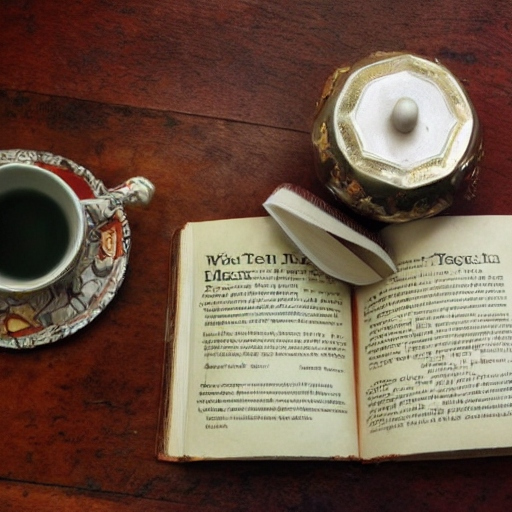
One of the recent and lovely additions to my daily routine is that my son has got me started drinking tea in the afternoons. The new habit of afternoon tea involves sampling multiple infusions of Chinese fermented varieties or Tiawanese oolongs. This simple repetition of waiting, smelling, and tasting draws me back into the moment and allows a break from my busy day and all the oh-so-important things I have to do. What wisdom there is in this time honored worldwide ritual of afternoon tea!
Reading books is something most people don���t seem to do so much of anymore. We do a lot of reading, but it���s the skimming and scrolling type of reading. I, for one, don���t spend enough time with my feet up, sitting in front of the fire, a cat curled in my lap and my nose in a book. I���ve been trying to keep a habit of dipping into a fantasy novel at bedtime.
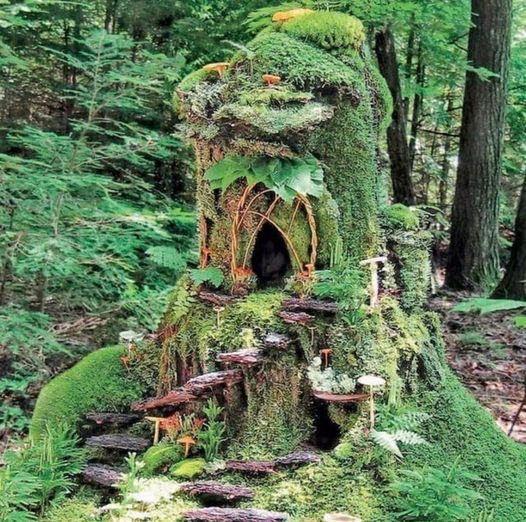 Photo: Tracy Birrell
Photo: Tracy Birrell I live in a place where I can enjoy the smell of the woods, the crashing of the waves, the pleasure of a broad vista. There���s mountains and islands, forest and wetlands to explore. Yet if I���m not careful, the weeks can fly by and I waste these opportunities. I���ve never regretted dropping everything and heading for the beach. My life is more productive if I take time to feed my spirit with the beauty of nature and take deep breaths of the open air. Relaxing in this way helps me to have a quiet joy in just being fully myself.
But you know, for me, it always comes back to the sense of wonder. On those hikes through the woods, it���s important to pause and view that fabulous rock formation from several angles or feel the bark of the astonishingly tall fir. I especially love to stumble upon a fairy ring. Out in the woods, things become clear: I can choose to use my imagination for worrying and absent-mindedly cycling through unnecessary stress. Or, I can use it for speculating about what kind of creature might live inside that hollow tree.
August 14, 2022
The Dairy
 H.A. Byrd
H.A. Byrd I walk dogs. My small, one-person business pairs well with the process of writing books. I���m lucky to live in a historic ���old town��� of a semi-rural region. This hilly, wooded area offers me lovely places to walk while I gather inspiration. The bend of a spectacular, ever-changing river flows right through my walking range, and the trail which runs across the street from my house offers sixty miles of strolling along old railroad grades.
One of my favorite places to take the dogs is an old dairy farm set right in the very crook of the river. Some of the property is up on a bluff, the rest is river bottomland, green and fertile, bounded by alder woods and then stony beach. Dogs love it there. There���s open fields, a swimmable, broad and rocky area of the river, and more interesting smells than a dog knows what to do with. I love it there, too.
I didn���t grow up in this town, but I���ve been walking daily in the area for five years or so. I���ve come to know the community within an hour���s walk from my door. I���ve seen some gorgeous historic buildings fall to the hands of greedy developers, and it broke my heart to watch the dairy���s old barn get bulldozed.
 "Oregon dairy cows" by Oregon State University is licensed under CC BY-SA 2.0 [image error][image error][image error]
"Oregon dairy cows" by Oregon State University is licensed under CC BY-SA 2.0 [image error][image error][image error] When one spends time in a place a certain sort of bonding is bound to happen. It���s a kind of mutual ownership. The land, in a way, begins to belong to the person. And, in a way, the person begins to belong to the land. There���s a connection which takes place, a mutual trust between the person and the spirit of the land. This is a powerful bond, strengthened by generations of occupation. So, although I have no actual claim to the old dairy land, I feel that it is a part of myself.
They put the signs up a few years ago. I knew they���d be ripping out the beautiful old barn. I knew they���d fill the bluff with ticky tacky quadruplexes. A sports field complex is planned for the bottomlands. This, and word of the similar destruction of another breathtaking piece of nature where I walk dogs just north of town, broke my heart. My family and I seriously considered moving out to a remote area on the open coast.
 "dairy cows" by pascalk is licensed under CC BY-NC-SA 2.0 [image error][image error][image error][image error]
"dairy cows" by pascalk is licensed under CC BY-NC-SA 2.0 [image error][image error][image error][image error] But, we stayed. And I decided to feature this dairy land as a backdrop for one of the short stories in my upcoming book. I wanted to honor the land. Honestly, I also wanted the people who move into those new homes to read about what lay under their built-in-a-day foundations. I care about history. As I researched the history of the farm for my story, I learned more than I had bargained for. And largely, what I learned was about myself, my attitudes, and how easily influenced I am.
At first, I found out that the old farmer had supported local sports and had donated the lowlands to the city. This made me feel better about the whole thing. I have no use for sports fields myself, but some people do, and it was the farmer���s wishes. It will ruin the scenery, which is sad, but it felt better to know about this. Later I found out that he���d given some land to the city, but made tidy millions by selling the rest of his bottomland to them. Okay, fine. Then, as I learned more by talking with some of the elders in the community, the story changed. My information is unverified, but the impression now is that this farmer was not a nice man. Not at all.
 "Shelburne Farms (1886) ��� Dairy Barn (1891)" by origamidon is licensed under CC BY-NC-ND 2.0 [image error][image error][image error][image error]
"Shelburne Farms (1886) ��� Dairy Barn (1891)" by origamidon is licensed under CC BY-NC-ND 2.0 [image error][image error][image error][image error] In addition I learned that, while my idyllic image of dairy cows grazing in the bottomland may have been true in the past, for quite some time most dairy cows have spent their entire productive lives standing on cement, never leaving the barn.
My heart has gone through connecting with the land, to feeling defensive of it, to then feeling humbled by my out-of-towner ignorance. Now, I see that the picture is more complicated than I had assumed. I realize I���ve had a series of assumptions on which I���ve based my feelings, and most of these assumptions were wrong! At this point my perspective is that it���s a good thing the farm is no longer in operation. The area below the bluff is now open for public use. That���s why I���ve been able to enjoy it. I still can���t really forgive them for the barn, though. They could have incorporated it into their housing complex as a shed or recreation facility. That farm dated from 1890, the greedy bastards.
July 16, 2022
Travel

There are reasons the story Aru's Realm begins with a horse drawn vehicle traveling through the woods.
When I was a kid there were only a few TV channels. It was normal to watch for an hour or so after school and then go outside. We also read comics, and books, some of us, and played board games. I drew a lot, mostly horses. My specialty was horses of unusual length. These guys had cylindrical bodies which stretched all the way across the page. It made sense, though. Legs are tough to sketch, and what I most enjoyed drawing was the tack. I made saddles and bridles in detail, and the martingales, breeching, saddlebags. Those long, long horses could fit quite a few western saddles, or seat several knights in colorful regalia.
In what might seem like contrariness to my own thinking, I created a slew of carts and wagons pulled by normal-length horses. With a child's obsession for power, I produced elegant eight or ten horse teams of draft animals for every cargo wagon. I went to great effort to make all those legs because each pair of horses would require a set of collars and harness. Not only was it fun to draw the harness, some primal superstition told me that if I drew these beasts and their rigs I possessed them, somehow. And for some funny reason, having animals as transportation has always given me a sense of security.
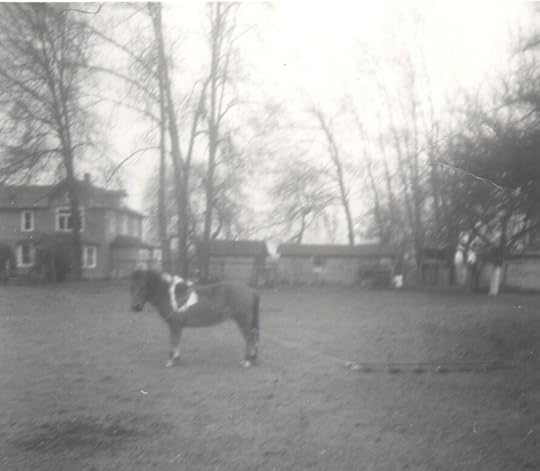
When I was eleven or twelve I constructed harnesses out of baling twine and made my pony drag a ladder around our field. I love working with animals. Over the years I've ridden horses, mules, ponies, donkeys, a cow, and (accidently) a reindeer. I've driven both a dog sled and reindeer sleighs. Once I sat by a tinker's fire in Ireland and talked with him about wagons until his wife in the caravan noticed me and came out to drive me off. Years ago in Seattle, I was invited to go inside a semi trailer and see the Budweiser Clydesdales wagon up close, because I was building my own wagon. But I don't ever recall having ridden in a horse drawn wagon.
After high school, I headed off to college (in the days before widespread awareness about cultural appropriation) with plans to construct a full-sized replica of an English Romany caravan (a vardo) as an academic project. I then would traveI in it across the US. I'd always loved Toad's canary yellow caravan from The Wind in the Willows. Also, I'd seen a funky version of one during my childhood years in Canada, it drove by on rubber tires with a goat bleating from the back porch. I wanted traditional wooden wheels on mine, though. In the university library I found a treasure.

The English Gypsy Caravan by C. H. Ward-Jackson & Dennis E Harvey was my manual. We no longer use the term Gypsy, but that is the title of the book. I still treasure the letters from Mr. Harvey, who kindly encouraged me. I managed to obtain a beautiful set of wooden wheels, just the right sizes. I spent hours sanding the old paint off and applying wood preservatives. A friend (underpaid) lengthened the axles for me and cut the fifth wheel ring-plates from a sheet of steel. I laminated strips of ash into beautiful curved members for the fore-carriage. My boyfriend made me a stained glass window for the front door, my parents gave me a gimbaled kerosene lantern for my birthday. My old cowboy friend found some gorgeous draft harness for me to buy, with so many shiny brass fittings. My parents wondered, later, where I came up with the money to buy all these things. I told them. I'd saved virtually all the money they sent me to live on that first year of college, subsisting on chili and fresh-ground corn, and cabbage from the garden spread with peanut butter. My father was flabbergasted, but I felt it was in my right. After all, I could have gone to town and eaten pizza but chose to sacrifice. Kids have different ideas about their parents' income than parents do!
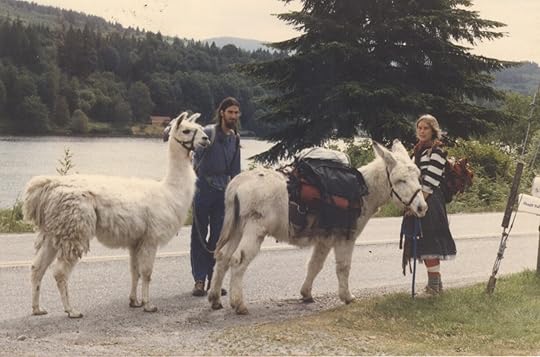
Eventually, my dream of traveling in the wagon was traded for a three hundred mile hike over the Cascade Mountains, starting from my doorstep in Bellingham. I owned with my partner at the time, dear Karl, a beautiful white llama named Oly. I had a large white long-haired donkey named Wilbur. They packed our load, although we ended up carrying Oly's share most of the way on our own backs due to our poor design of his panniers.
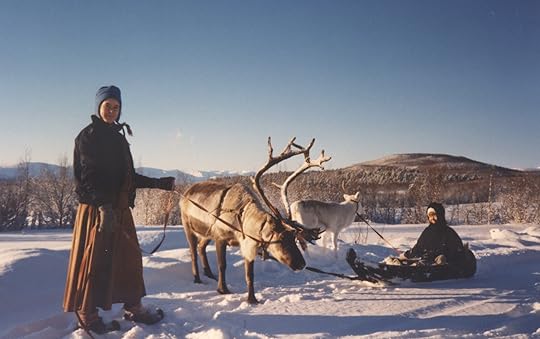
The living wagon in which Aru travels during the first chapter of the story is plain and grey and not a vardo or showman's wagon. Aru and her family are not based in any way on Romany travelers. I avoided direct allusions to use of these caravans in our world outside of the pages. But those old wagons, products of pride and spirit, were a part of my youth. It's the same with Sami sleighs, I spent some of the favorite hours of my life traveling alone through snowy woods or on the frozen lake, listening to nothing but the swish of the snow and the little noises of the reindeer. I include these vehicles respectfully in Aru's Realm because they are part of who I am.
May 26, 2022
What is Fantasy Fiction?

What defines the fantasy genre? Does this label mean that the story involves magic? By definition, the fantasy genre consists of fiction not bound by the natural laws of reality or by human history. Fantasy does, however, explore human nature. Today's imaginative writing is often inspired by mythologies and folklore, and although magic is usually involved, it's not a requirement.
I'd say that virtually all ancient writings could now be considered fantasy because the understanding of our world has changed enormously, including what people know as real. This fact in no way diminishes the importance of these works. Great minds of the past have much to teach us about ourselves and even about modern life. The difference, of course, between traditional works and what we now consider to be the fantasy genre is that in our times the authors are known and the writing is understood to be fictitious.

But what is fiction, really? Here in reality, I find it absolutely astounding that life forms are possible. What is weirder, stranger, more fantastic than the fact that our universe exists? That we live? How unlikely the fact of our existence is! We define fiction as what is invented, imaginative, or not based on fact. But if you think about it too much, you'll see it's not clear where the boundaries are between fiction and truth. There is a thin line between what is invented or imagined and what exists somewhere already. Science gives us powerful tools for understanding our world, based on demonstration and proof. But there are more etheric elements of reality that science can't demonstrate. This is where the difference between fantasy and reality can become blurry.
Anyhoo, fantasy is an exciting subject of academic study because of the historical, cultural, linguistic, psychological and philosophical aspects of stories. One aspect of this type of literature is the chance to see how thinking has changed or stayed the same over the years. Nothing is more wonderful than when someone from long ago eloquently puts into words a personal realization you've had but perhaps hadn't brought to the surface of your mind. I delight in reading fantasy which paints my inner vision with possibilities that stretch the imagination.
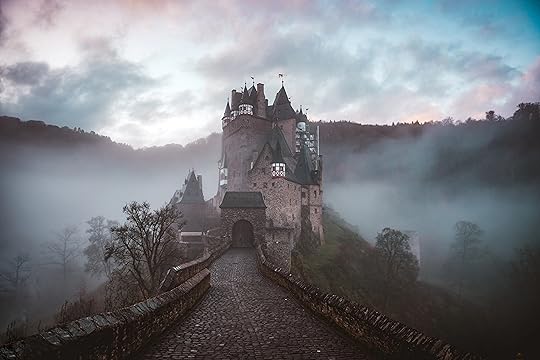
What we think of as fantasy fiction developed out of the chivalric romances of aristocratic post-medieval Europe. Cervantes wrote Don Quixote during the birth of modern fantasy. George MacDonald, a Scottish minister of the nineteenth century, wrote fantasy stories for adults and children which are credited as the first clearly fictional tales. He was a mentor of Lewis Carroll and a major influence to many of the greats who came after him. William Morris followed by inventing a fantastic world to exist outside our known world. These men were Tolkien's foundation as he created the first high fantasy story.
Modern authors continue on with the development of the fantasy genre. I stand in awe of how fantasy storytellers have built upon the work of their forebears for thousands of years. Those ancient mythologies have never left us.
January 20, 2022
The magic in life

Remember the stories from your childhood? The books read to you, and then the ones you read yourself? Maybe you remember movies, oral stories, or theater. Most people remember only a fraction of the stories they grew up on, but nonetheless these stories did much to shape us into who we are. This process continues in adulthood.
The way I see it, we become what we expose ourselves to in life. What we surround ourselves with becomes our world. In these times we have an extraordinary amount of choices to make, and a historically unprecedented amount of control over our lives. I choose beauty in my life whenever possible. There must be some sort of balance, yes. Nature is cruel at times, and the world is not well-run by humankind. We must learn from the darkness, only fools ignore it. But, that said, I want my life to be filled with love and beauty as much as possible.

People are tired of syrupy love stories and magical thinking. The thing is, when we dive deep, we find that the foundations of the world have quite a bit of magic lurking in the cracks. Magic is used by the ignorant to explain life. Does this mean there is no such thing? Of course not! Most of us experience some level of magic as we make our way through our days. For instance, it is a basic principle of magic that what you focus on will become your reality. It���s wise to spend time on what you enjoy. In my case, that���s reading beautiful prose and uplifting, meaningful, or humorous fantasy stories.
The line between fantasy and reality can narrow to almost nothing. A peek into the unreal may free the mind, allowing inspiration and revelations. Through the imaginings of others we can learn so much about our own perspectives.
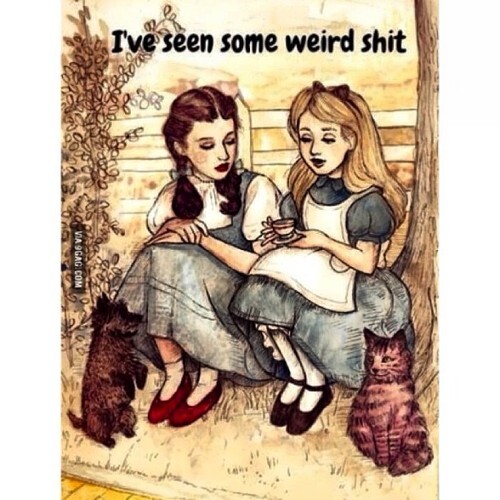
It really doesn���t make sense that we exist at all. Nothing is more crazy than the fact that there is something more than a dark, empty void. How even can a void exist? Why shouldn���t magic be a part of all this fantastic reality? I have lived my life in such a way that I���ve experienced some bizarre things. And that is why I love this image of Dorothy and Alice so much. I���ve framed it and placed it on the bureau in my bedroom. I laugh when I notice it.
The titular character in Aru���s Realm walks this fine line between magic and madness. Those who study cultural anthropology know that often, in indiginous cultures the world over, it was the ones with the funny look in their eyes who were trained as shamans. It���s a fact that mental illness can open doors to worlds most don���t see. And although the seemingly obvious answer is that these people are delusional, life is more complicated than this. Certainly delusion exists, but magic does also. The ability to tell the difference is what makes someone a shaman rather than a madman.
Is there anyone, though, who doesn't have some form of a mental condition? Our entire society is made up of the characters from Winnie the Pooh, as far as I can tell. Like everything in our lives, it���s a matter of degree.
Each of us is capable of seeing the magic in life. Those who, for whatever reason, find their mind less inclined to censor itself, are the ones who tend to dream, explore with their imagination, and to need a creative outlet. Ultimately, ���we���re all mad here.��� That may not be a bad thing.
December 10, 2021
Life is what we make it

When Grandma Moses said "life is what we make it," this referred to making the best of what life brings. But my own life has taught me, again and again, the more literal meanings of this phrase.
Certainly attitude affects our experience. A close friend once told me that she admired my fortitude. She said I'd been through so much in my life and yet I managed to remain positive. These words shocked me. Had I been through an unusual amount of adversity? I had to think about this for a while. I then realized that many people wouldn't want my life, with all the shifting around I've been compelled to do. My family and I have lived in many regions of the United States. We've learned about small towns, the city, and about dirt poverty versus the daily lives of the ultra rich. We've had some outrageous times. I'm thankful for it all. I'm an adventurer. I love my life.
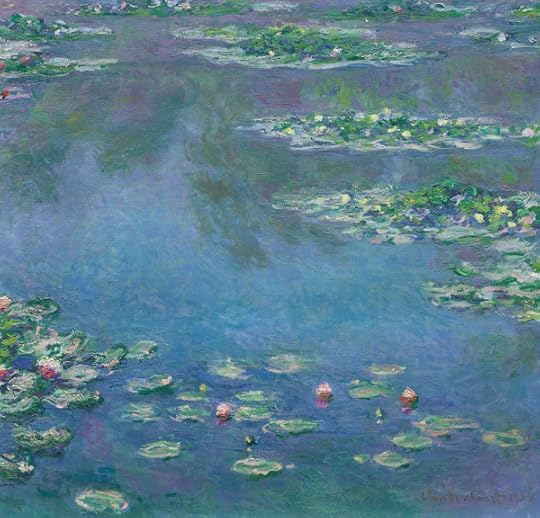 Claude Monet
Claude Monet Yes, attitude shapes our reality, but so does perception. Here is one of many of Monet's paintings of the pond in his garden. If you squint it looks like a photograph. If you don't squint you can see how each brush stroke represents a play of light. The painting demonstrates a human interpretation of nature's beauty. Writings of fiction also describe life as perceived by humans. I love to read the many ways authors have created something special with what we were given. This is why I especially love literary fantasy. Creativity, to my mind, is what gives humanity value. When I see on Facebook that someone has dressed up a cat in a pirate costume, and the effect is striking, I think ���Yes! This is why humans exist! To do things like this!���
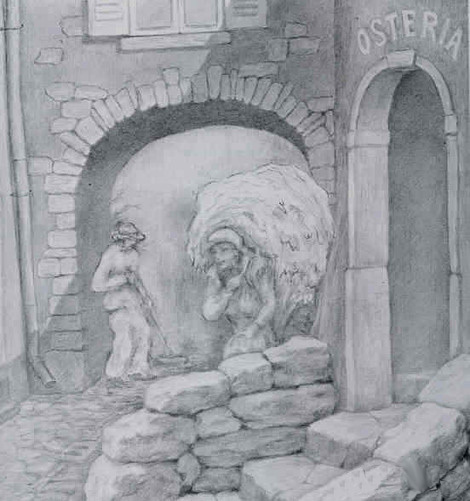 Sandro del Prete
Sandro del Prete It's important to remember, too, that we each think differently. Not only do we come from different backgrounds, our physiological makeup determines how we experience life. Some people see smells. Many people think their thoughts without seeing any sort of image in their mind. Others have memories in technicolor video and surround sound. In addition, memories are selective and often mistaken. No wonder we have different perspectives! It's amazing that we can understand each other at all, really. Yet we do deeply relate to one another. We recognize ourselves in each other. And it's just that humanity that we see within others that we share as art.
Life is what you make it, and to me life is art.



